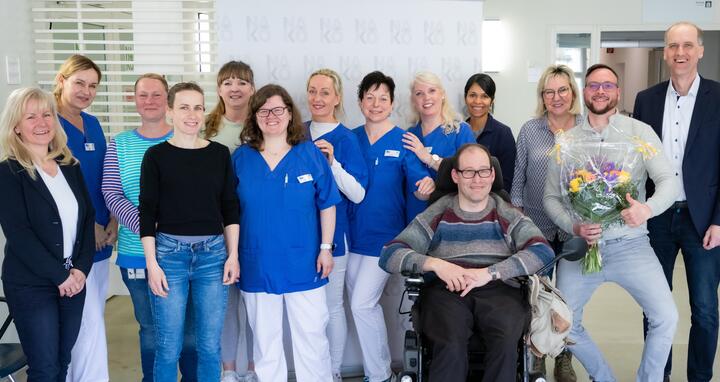“We see how people’s health develops over time”
The 5,555 participant, Markus Grosse, during his second examination for the NAKO Health Study.
When, at noon, the examiner fetches her guest Marcus Grosse from an adjoining room into the foyer, he has already been at the NAKO health study’s Berlin-North Study Center since 7:45 that morning. The 38-year-old is here for the second time, having taken extra time off for his visit to the Max Delbrück Center in Buch. The research team collects “biosamples” such as blood and saliva and examines Marcus Grosse from head to toe: Are his bronchial tubes inflamed, and is that perhaps why he is exhaling more nitrogen than usual? How are his blood pressure and heart rate doing? And what about his eyes and teeth? How strong is his hand grip? Where’s his fat located? How fit are his body and mind? Interviews are conducted as well as physical examinations and tests like those done at specialists’ offices. “I’m more than happy to participate,” says Grosse. “Where else can you get such a thorough check-up? And it’s for a good cause, too!”
The NAKO health study (German National Cohort/NAKO) has been running since 2014. The researchers want to more precisely identify risk factors for major chronic diseases and develop new strategies for early detection and effective prevention. The first round, which consisted of baseline examinations on around 205,000 subjects throughout Germany, has already been completed. “These data sets and samples are now available for research purposes,” says Professor Tobias Pischon, head of the Molecular Epidemiology Lab at the Max Delbrück Center and a member of the NAKO board of directors. For the second round, the Berlin-North Study Center will examine up to twelve people each day from now until April 2024.
Scanning the entire body, piece by piece
We can see how people’s health develops over time: for example, whether a cyst like this regresses on its own. That’s our strength.
Marcus Grosse is subject No. 5,555. He is presented with a bouquet of flowers as the entire team gathers around him for a photo. “It’s actually me who should be thanking you,” he tells them. “You explain everything so well!” But then he’s off again, for magnetic resonance imaging (MRI). The machine scans his entire body, piece by piece, in an hour’s time.
People normally go to their doctor when they have symptoms of being sick. An MRI scan can then, for example, reveal a liver cyst. Then the question is: Does something need to be done about it? Or does the cyst actually cause no harm and any intervention would be excessive? In day-to-day medical practice, the reference values needed to make such a decision are often lacking.
NAKO participants undergo repeat examinations at set intervals – regardless of whether they are healthy or not. A third round of examinations with the subjects is already planned, so the study will continue until at least 2028. “This will allow us to systematically observe subclinical phenotypes, which are anomalies that don’t produce any symptoms,” says Pischon. “We can see how people’s health develops over time: for example, whether a cyst like this regresses on its own. That’s our strength.” There has never been a comparable population-based cohort study in Germany, he adds.
Text: jas
Further information
- NAKO at the Max Delbrück Center
- German National Cohort data accessible for research
- NAKO TransferHub






